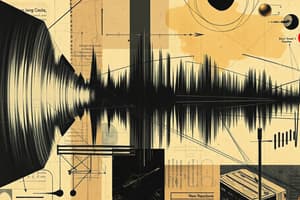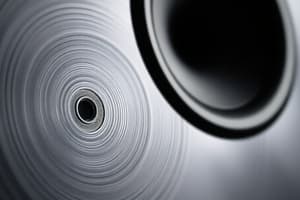Podcast
Questions and Answers
What happens to the sound when you hold the plucked string?
What happens to the sound when you hold the plucked string?
- The sound changes pitch.
- The sound becomes louder.
- The sound intensifies momentarily.
- The sound completely vanishes. (correct)
What is necessary for sound to travel?
What is necessary for sound to travel?
- A solid surface
- Magnetic fields
- Electricity
- A medium (correct)
What type of wave is sound classified as?
What type of wave is sound classified as?
- Transverse wave
- Longitudinal wave (correct)
- Electromagnetic wave
- Surface wave
Which phenomenon describes a region of decreased pressure in a sound wave?
Which phenomenon describes a region of decreased pressure in a sound wave?
What is one of the key qualities used to describe a wave?
What is one of the key qualities used to describe a wave?
Why can't sound travel through a vacuum?
Why can't sound travel through a vacuum?
What is produced when a vibrating object compresses surrounding air molecules?
What is produced when a vibrating object compresses surrounding air molecules?
What primarily influences the loudness of a sound?
What primarily influences the loudness of a sound?
What type of wave is sound classified as?
What type of wave is sound classified as?
What effect does wind have on sound propagation?
What effect does wind have on sound propagation?
Which of these statements about sound propagation is incorrect?
Which of these statements about sound propagation is incorrect?
Flashcards are hidden until you start studying
Study Notes
Sound Production and Observation
- Sound is produced by a vibrating body and travels in wave form, requiring a medium for propagation.
- When a string on a bow is plucked, sound occurs as long as the string vibrates; holding the string halts the sound.
- Vibrations can be observed using a small paper strip or by applying powder to percussion instruments like tabla, which reveals disturbances.
- Striking a steel tumbler demonstrates that holding it stops the vibrations and sound.
- Sound waves are vibrational energy transmitted through mediums, which can be air, water, or solid materials.
Nature of Sound
- Sound is classified as a longitudinal mechanical wave and cannot travel through a vacuum, such as in outer space.
- Sound waves consist of compressions (regions of increased pressure) and rarefactions (regions of decreased pressure).
- Key parameters of sound waves include wavelength, amplitude, frequency, and time period.
- Loudness is influenced by sound pressure, the spectrum of harmonics, and duration.
Wave Propagation and Properties
- Sound propagates through compressible media (air, water) and can also travel through solids with specific modes.
- The speed of sound is influenced by the relationship between density, pressure, and temperature.
- Medium movement (e.g., wind) can assist in sound transport, while viscosity affects sound attenuation.
Sound Transmission and Absorption
- As sound waves touch surfaces (like walls), some energy reflects back while some penetrates, leading to sound transmission.
- The energy absorbed by materials converts to heat, determined by the sound absorption coefficient (α), which ranges from 0 (total reflection) to 1 (total absorption).
Differences Between Music and Noise
- Music is structured and harmonically pleasing, characterized by rhythm and periodicity, while noise is random and often irritating.
- Sound frequencies are categorized into low (bass), midrange, and high (treble); each affects the perception of sound quality.
- Humans are most sensitive to midrange frequencies, which provide energy and clarity.
Timbre and Harmonics
- Timbre describes the unique quality or character of sound, determined by the combination of fundamental frequency and its harmonics.
- Harmonics (or overtones) are frequencies beyond the fundamental frequency that enrich sound complexity; greater harmonics produce more pleasing sounds.
- Objects that vibrate produce sound waves of specific frequencies, and their vibrating ability influences the pleasantness of the sound.
Loudness and Volume
- Loudness correlates with sound intensity, where larger amplitude vibrations result in louder sounds.
- Comparisons are essential for understanding loudness levels, as significantly louder sounds (e.g., a dynamite explosion) displace more air molecules than quieter sounds (e.g., a cap pistol).
Studying That Suits You
Use AI to generate personalized quizzes and flashcards to suit your learning preferences.




